The GeForce GTX 760 Roundup: Gigabyte and EVGA Compared
by Ryan Smith on October 7, 2013 2:00 PM ESTOverclocking
Last but not least we have our customary look at overclocking performance. With both cards being custom cards, these cards have some notable differences between them. Chief of which in fact is that only the EVGA card can be overvolted to 1.212v. Gigabyte’s card, though having the overvoltage function exposed via NVIDIA’s drivers, doesn’t actually work, leaving the card at 1.2v max at all times. As a result EVGA’s 760SC ACX will get one more boost bin at a higher voltage to play with than Gigabyte’s card will.
Furthermore there is also a difference in power target adjustability that may also play into EVGA’s hands. The 760SC ACX can have its power target raised by 15%, but the 760OC’s can only be raised by 10%. However if our suspicions are right and Gigabyte has a higher default power target in the first place, then the difference should not significantly handicap the Gigabyte card.
| GeForce GTX 760 Overclocking | |||||
| GTX 760 (Ref) | EVGA GTX 760SC ACX | Gigabyte GTX 760 WF | |||
| Shipping Core Clock | 980MHz | 1072MHz | 1085MHz | ||
| Shipping Max Boost Clock | 1149MHz | 1228MHz | 1215MHz | ||
| Shipping Memory Clock | 6GHz | 6GHz | 6GHz | ||
| Shipping Max Boost Voltage | 1.2v | 1.2v | 1.2v | ||
| Overclock Core Clock | 1130MHz | 1130MHz | 1185MHz | ||
| Overclock Max Boost Clock | 1306MHz | 1300MHz | 1306MHz | ||
| Overclock Memory Clock | 6.5GHz | 6.5GHz | 6.8GHz | ||
| Overclock Max Boost Voltage | 1.212v | 1.212v | 1.2v | ||
Starting first with the GPU overclock, it’s interesting to note that we have a wide gap in base clockspeeds attainable, but not in the maximum boost clock each card reaches. As far as base clocks are concerned Gigabyte achieves 1185MHz versus EVGA’s 1130MHz, which is 100Mhz (9%) and 58MHz (5%) over stock respectively. But at the maximum boost clock it’s 1306Mhz for Gigabyte and 1300MHz for EVGA, a difference between the cards of only 6MHz, making it a practical tie. The fact of the matter is that these cards will rarely reach their maximum boost bins and we expect there to still be some kind of a performance difference, but it means they’re going to spend most of their time on equal footing, more so than the base clocks would have us believe.
Meanwhile, like GPU overclocking memory overclocking sees the Gigabyte achieve the better overclock. Here the 760OC tops out at 6.8GHz while the 760SC ACX tops out at 6.5GHz. 6.5GHz is fairly common for a GK104 card, while 6.8GHz would be doing better than average in our experience. We are definitely memory bandwidth limited at times even on the lower performance GTX 760, so the 5% additional memory bandwidth may be useful for Gigabyte. The question going into our testing will be whether Gigabyte’s higher memory overclock and higher base GPU overclock will give them a significant boost, or if TDP restrictions and similar maximum boost clocks will keep the two cards close together.
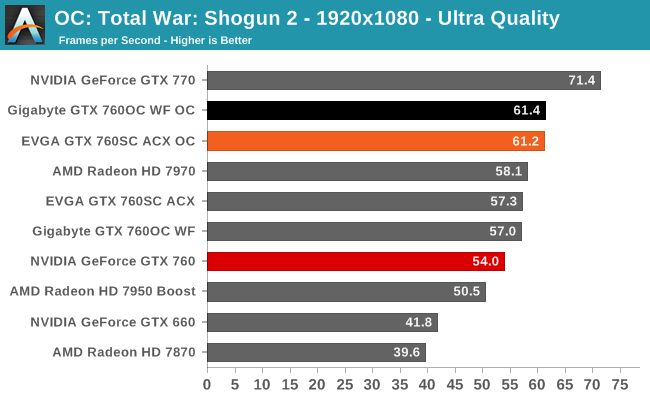
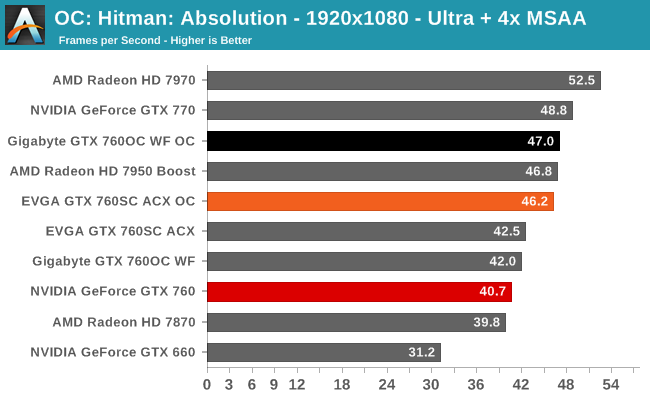
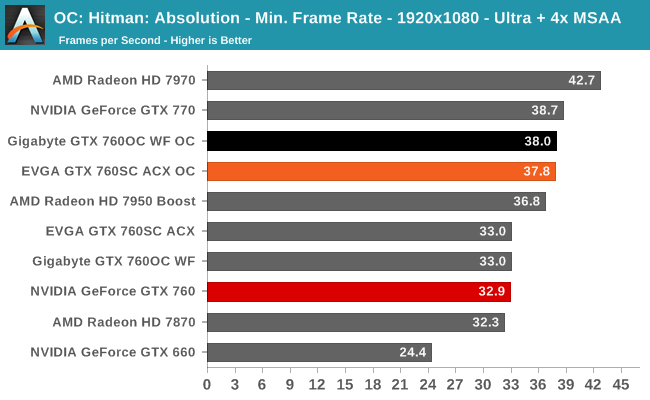
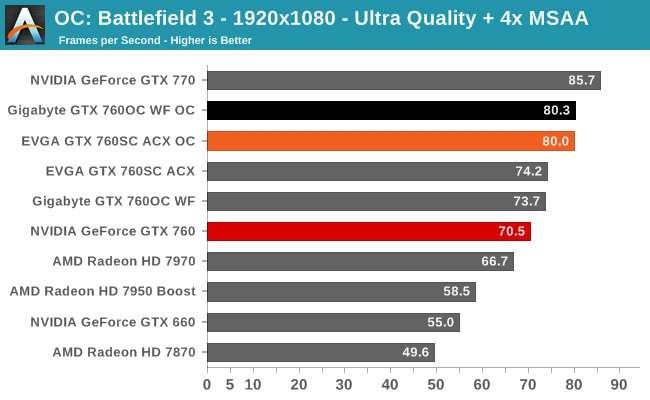
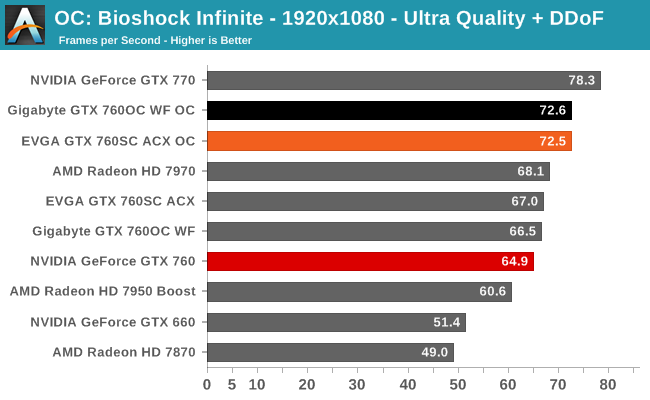
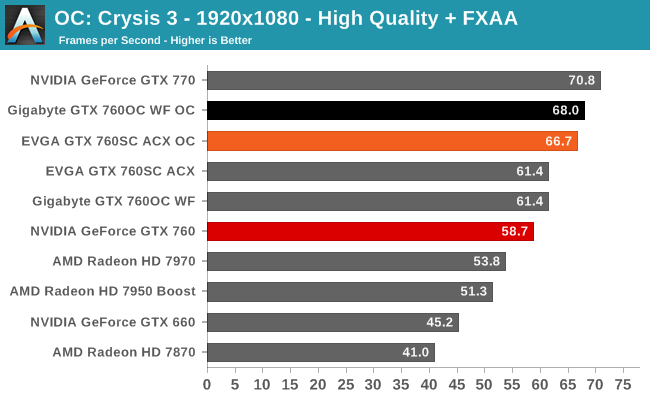
Ultimately the performance differences between the two cards when overclocked is under 2%, despite the higher base and memory overclocks on the Gigabyte card. Gigabyte is consistently in the lead here, even if by just 1/10th of a frame per second, but it’s barely over what experimental variation would give us. Looking at the two cards there’s no reason not to take 2% more performance, but it’s not going to make much of a difference.
With that said, both cards do well for themselves here on an absolute basis due to the combination of their GPU and memory overclocks. The end result of all over this overclocking is 9%-11% improved performance versus their out of the box performance, and upwards of 15% over a stock clocked GTX 760. These are very solid performance improvements, so we’ll have to see what the power and acoustic costs will be.

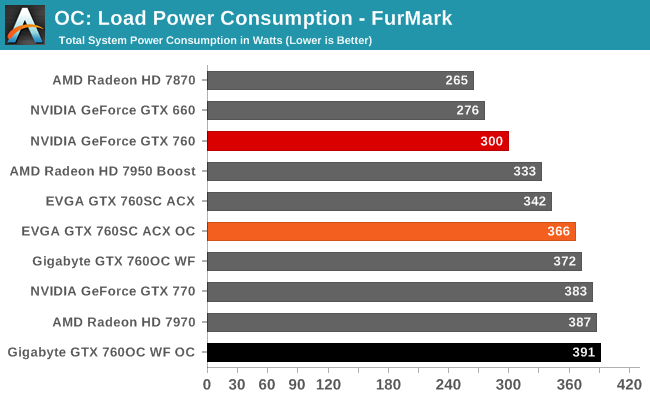
Moving on to evaluating the power, temperature, and acoustic costs of overclocking, as we can see the power costs of overclocking are low-to-moderate. For the Gigabyte card the difference is 23W at the wall under BF3, and a smaller 19W under FurMark. Considering we can’t access the overvoltage boost bin on this card this is a fairly reasonable increase in power consumption, though as with overclocking the reference GTX 760 we are pushing the card off of its ideal performance/power regardless.
Meanwhile for the EVGA card the power cost is just 11W under BF3, and 24W under FurMark. The latter is due to the larger power target increase the EVGA card allows (15% versus 10%) while the BF3 power increase is actually lower that what we’d expect; the reference GTX 760 with similar voltages and power target options saw an almost 40W increase here. This outcome actually equalizes the EVGA and Gigabyte cards a bit under BF3, though with both cards we’re now approaching the power consumption of the stock GTX 770.
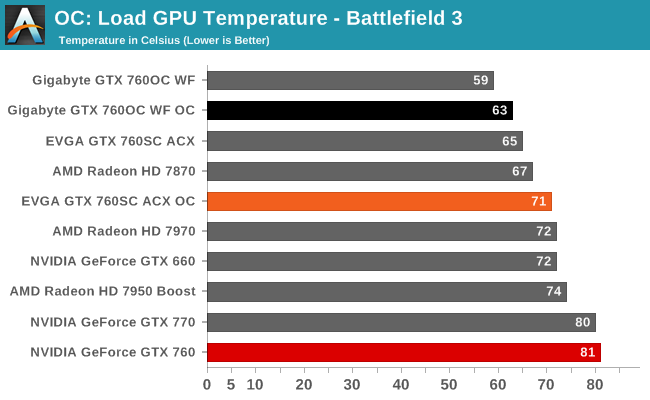
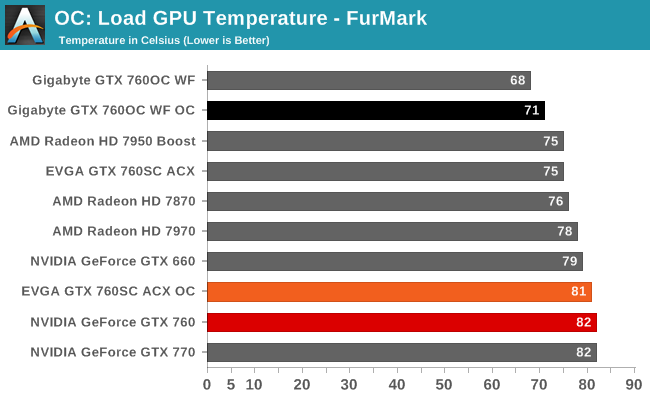
Overclocking has the usual impact on load temperatures, sending them higher in call cases. The EVGA card gets the worst of it, with temperatures rising by 6C under both test cases. The Gigabyte card fares better in that respect, with temperatures rising by just 3C. The end result is that the gap between the cards only grows, with Gigabyte’s card hitting the 60s under gaming and the 70s under FurMark, while EVGA’s card hits the 70s under gaming and the 80s under FurMark. Though it bears repeating that 81C in this case is not the temperature throttle’s work since all of the throttles, temperature included, are raised when we’re overclocking.
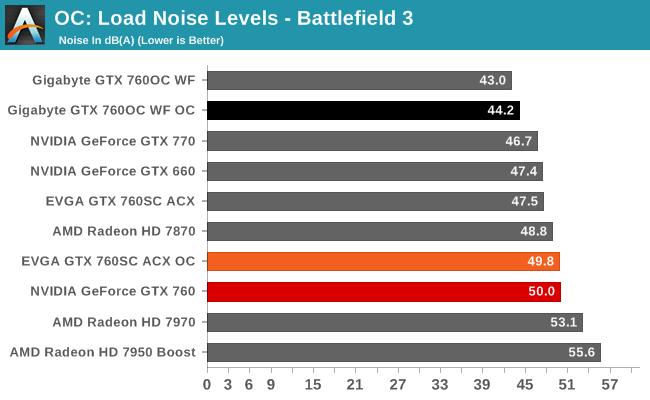
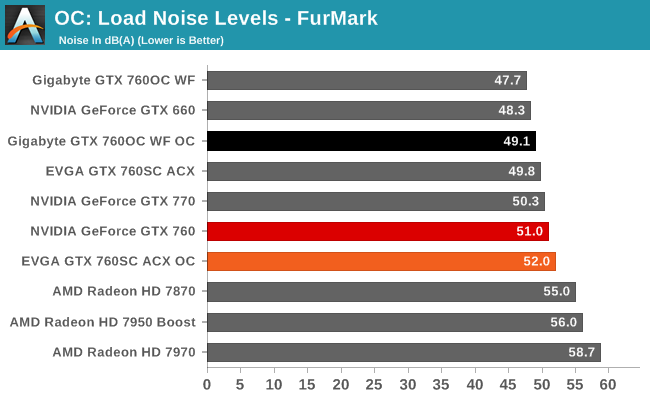
Finally we have the matter of noise, which as is usually the case is going hand-in-hand with temperature. Once more Gigabyte’s card fares the best here, with noise rising a hair over 1dB under both BF3 and FurMark, topping out at 44.2dB and 49.1dB respectively. 44.2dB under a gaming workload isn’t going to be silent, but it’s not too far off of it.
EVGA’s card on the other hand is approaching and exceeding 50dB, with BF3 topping out at 49.8dB while FurMark tops out at 52dB. Like the noise levels under stock, these levels aren’t too far off the mark for an open air cooler when overclocking, but in this case they’re simply not going to be very impressive standing next to the Gigabyte card.
Ultimately overclocking is solidly in Gigabyte’s favor due to cooling considerations. The gaming performance from overclocking their card is not significantly different from the EVGA card and other GTX 760’s we’ve overclocked – which is fairly consistent for GeForce 700 series cards – but what seals the deal for Gigabyte is the fact that even with this overclock they’re still under 45dB for load noise in our gaming workload. Coupled with the lower temperatures and slightly lower power consumption under our gaming workload, and it’s clear Gigabyte is the strongest contender among our GTX 760 cards.










22 Comments
View All Comments
hags2k - Monday, October 7, 2013 - link
I like the design of the GB card and really do think it's superior, but I've grown to really love EVGA's software package and have made use of their transferable warranty twice already - the "added value" really is value in this case. It's a tough call!Subyman - Monday, October 7, 2013 - link
I have a MSI TF 760 and couldn't be happier. I compared them all when they first came out and the MSI and GB were the quietest and coolest. I was very pleased with the quality especially considering the price. Would live to see the MSI represented.Teizo - Monday, October 7, 2013 - link
Not sure why you guys didn't include the MSI 760 Gaming, or the ASUS Direct CU. I guess you didn't have them on hand.ShieTar - Tuesday, October 8, 2013 - link
Since the 760 is showing consistently >80% of the performance of a 770, at 60% of the cost, and since NVIDIAs drivers seem to handle framepacing in SLI mode quiet well now, I would really love to see some performance tests for a set of 760s in SLI. Could you please add those tests?Impulses - Tuesday, October 8, 2013 - link
Yeah SLI 760s seem like a terrific value, faster than any single card by a good margin and cost effective enough as to make the 770 a bit irrelevant... I'm trying to decide whether to get two 760s, as an upgrade from my 6970 x2 setup, or save up for 780 x2...Nfarce - Tuesday, October 8, 2013 - link
Guru3D has just such an animal of a review dating from this past June. Just Google "GeForce GTX 760 SLI" and you'll see the link right up there at the top two or three links that come up. The only downside is they don't review all the games (no BF3, no Crysis 3, no Far Cry 3 specifically). But it beats the Titan in Tomb Raider & Bioshock Infinite by 13-18% at 2560x1440. Very nice bang for the buck.idiot consumer - Sunday, October 13, 2013 - link
It is nice to see new gear coming out BUT:There are probably 50% of nvidia card owners with famous: "video driver stopped responding and has recovered"
There is no cure nor solution from nvidia or micro$oft.
The only solution is to buy new card until it happens again.
Forums all over the world are full of complaints.
How come that mayor reviewers like AnandTech could not care less?
Galidou - Sunday, October 13, 2013 - link
If they start to cover driver issues, both company wouldn't want their video card reviewed. The point here is to show the performance, not the possibility of various bugs/problems unless they're critical, BUT:I have a gtx 660ti for a year now and the problem has cursed me for a long time. It is/was worse in some games. I fixed part of it going to an earlier driver. I had a 6870 + 6850 in crossfire(I thought if I had any problem with crossfire I could disable it and play with the 6870) and never had a trouble with them, EVER.
idiot consumer - Sunday, October 13, 2013 - link
If they start to cover driver issues, both company wouldn't want their video card reviewed. The point here is to show the performance, not the possibility of various bugs/problems unless they're critical,Considering that nvidia suffered class lawsuit - in US only - unfortunatelly and has settled it confirms that issues are critical.
Good old days of excellent nvidia cards have gone forever.
I shall never buy from nvidia anymore.
Ryan Smith - Monday, October 14, 2013 - link
We report on things we see first hand and things we can reproduce. And right now we can't reproduce any NVIDIA driver stability issues (and not for a lack of trying).